#Rural Health Programme
Explore tagged Tumblr posts
Text
Actions for Micro-finance Institutions.

Microfinance institutions can ensure that rural credit programmes benefit tobacco growers who are looking to shift so they can be supported to purchase inputs needed to grow alternative crops.
PAHO - World No Tobacco Day 2023. May 31st.
#world no-tobacco day#31 may#world health organization (who)#Microfinance institutions#call to action#Actions for Institutions#rural credit programmes#Tobacco growers#Tobaacco farmers#We need food - Not Tobacco#alternative crops#food insecurity
0 notes
Text
"The Netherlands is pulling even further ahead of its peers in the shift to a recycling-driven circular economy, new data shows.
According to the European Commission’s statistics office, 27.5% of the material resources used in the country come from recycled waste.
For context, Belgium is a distant second, with a “circularity rate” of 22.2%, while the EU average is 11.5% – a mere 0.8 percentage point increase from 2010.
“We are a frontrunner, but we have a very long way to go still, and we’re fully aware of that,” Martijn Tak, a policy advisor in the Dutch ministry of infrastructure and water management, tells The Progress Playbook.
The Netherlands aims to halve the use of primary abiotic raw materials by 2030 and run the economy entirely on recycled materials by 2050. Amsterdam, a pioneer of the “doughnut economics” concept, is behind much of the progress.
Why it matters
The world produces some 2 billion tonnes of municipal solid waste each year, and this could rise to 3.4 billion tonnes annually by 2050, according to the World Bank.
Landfills are already a major contributor to planet-heating greenhouse gases, and discarded trash takes a heavy toll on both biodiversity and human health.
“A circular economy is not the goal itself,” Tak says. “It’s a solution for societal issues like climate change, biodiversity loss, environmental pollution, and resource-security for the country.”
A fresh approach
While the Netherlands initially focused primarily on waste management, “we realised years ago that’s not good enough for a circular economy.”
In 2017, the state signed a “raw materials agreement” with municipalities, manufacturers, trade unions and environmental organisations to collaborate more closely on circular economy projects.
It followed that up with a national implementation programme, and in early 2023, published a roadmap to 2030, which includes specific targets for product groups like furniture and textiles. An English version was produced so that policymakers in other markets could learn from the Netherlands’ experiences, Tak says.
The programme is focused on reducing the volume of materials used throughout the economy partly by enhancing efficiencies, substituting raw materials for bio-based and recycled ones, extending the lifetimes of products wherever possible, and recycling.
It also aims to factor environmental damage into product prices, require a certain percentage of second-hand materials in the manufacturing process, and promote design methods that extend the lifetimes of products by making them easier to repair.
There’s also an element of subsidisation, including funding for “circular craft centres and repair cafés”.
This idea is already in play. In Amsterdam, a repair centre run by refugees, and backed by the city and outdoor clothing brand Patagonia, is helping big brands breathe new life into old clothes.
Meanwhile, government ministries aim to aid progress by prioritising the procurement of recycled or recyclable electrical equipment and construction materials, for instance.
State support is critical to levelling the playing field, analysts say...
Long Road Ahead
The government also wants manufacturers – including clothing and beverages companies – to take full responsibility for products discarded by consumers.
“Producer responsibility for textiles is already in place, but it’s work in progress to fully implement it,” Tak says.
And the household waste collection process remains a challenge considering that small city apartments aren’t conducive to having multiple bins, and sparsely populated rural areas are tougher to service.
“Getting the collection system right is a challenge, but again, it’s work in progress.”
...Nevertheless, Tak says wealthy countries should be leading the way towards a fully circular economy as they’re historically the biggest consumers of natural resources."
-via The Progress Playbook, December 13, 2023
#netherlands#dutch#circular economy#waste management#sustainable#recycle#environment#climate action#pollution#plastic pollution#landfill#good news#hope
517 notes
·
View notes
Text



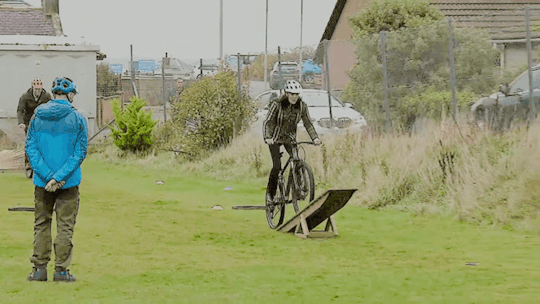








THE WALES DIARIES ♚
2 NOVEMBER 2023 || SCOTLAND VISIT (1/3) - OUTFIT MORAY
The Duke and Duchess of Rothesay visited Scotland to meet organisations supporting rural communities and those working provide mental health support to young people through access to the outdoors and practical learning.
For their first engagement of the day, Will and Cat visited Outfit Moray which delivers outdoor learning programmes to young people. The aim of the work is to encourage the generation to get outside and to help them develop life skills and improve their mental and physical health in doing so.
The charity helps children aged between eight and 18 who are vulnerable or from disadvantaged backgrounds. Some of the activities provided by them to the young people include mountain biking, paddlesports, rock climbing, archery and bushcraft. The charity also runs a number of programmes in local schools such as cycle training, bike maintenance and first aid programmes.
During their visit William and Catherine also joined in a mountain biking session through an obstacle course and spent time with the pupils from Burghead Primary School. They also witnessed the kids take part in a bike race themselves which was flagged off by Catherine.
#the wales diaries#the wales diaries 23#the engagement diaries#engagement diaries 23#engagement diaries#2112023#british royals#british royal family#royalty#royals#kate middleton#royal#brf#catherine middleton#duchess of cambridge#british royalty#prince william#william wales.#catherine wales.#royaltyedit#royalty edit#ScotlandNov23#ScotlandNov23.1#royaltygifs#the princess of wales#princess of wales#princess kate#princess catherine#prince of wales#the prince of wales
57 notes
·
View notes
Text
good news for women - march 2024
HUGE gains have been made for women's health worldwide!!
among 36 countries receiving world bank funding, there has been a 96% drop in maternal mortality! massive gains have also been made in providing contraception, lowering teen pregnancy, lowering child mortality, and connecting women in rural areas to health clinics! check out this report from the world bank to learn more
The Egyptian government has started cash transfer programs as a social safety net meant to empower women and keep girls out of child marriage. The Takaful part of the program provides monthly conditional cash transfers to poor households with children under 18 years provided they comply with health and education conditionalities. The Karama part of the program provides unconditional cash transfers to the elderly poor, orphans, widows, and persons living with disabilities. As of December 2023, the program has reached 4.67 million households (around 17 million citizens) and 74% of card holders are women.
This change has been widely supported by the French public and was overwhelmingly voted in by lawmakers!!
Though abortion rights are unstable in the United States, some pharmacy retailers are making abortion pills more accessible. Walgreens said it will start by providing the pill in a handful of pharmacies in New York, Pennsylvania, Massachusetts, California and Illinois. CVS's spokesperson Amy Thibault said it will begin dispensing the pill in all of its pharmacies in Massachusetts and Rhode Island "in the weeks ahead". Both companies said they will focus on rolling out in states where pharmacists are allowed to dispense mifepristone, and will monitor prospects where there are legal challenges to abortion bans or limitations, like Kansas, Montana and Wyoming.
In line with the Global Strategy to eliminate cervical cancer by 2030, WHO, Gavi, the Vaccine Alliance and partners, in collaboration with the Government of Nigeria, developed and implemented a multi-pronged prevention strategy to protect the lives of girls and women from the deadly disease. This includes the rollout of a mass HPV vaccination campaign targeting girls aged nine to 14 years to receive a single dose of the vaccine in 16 states. Between October 2023 and January 2024, 4.95 million girls were vaccinated against HPV.
#good news for women#radical feminist safe#radfems please interact#radfems do touch#terfs do interact#articles#radical feminism
2 notes
·
View notes
Text
Getting started.
Monday 18th September 2023.
Yesterday it was good to have breakfast with Linda, who had arrived safely. We were collected by Abdu and his minibus midmorning and came to Kampala. We were warned that the roads around Kampala would usually be busy on Sunday and Monday morning as it was the start of the new school term so parents would be taking children to school. We were early enough to avoid the worst of it but others later said the roads were very busy.
We had lunch at one of the cafes we know before going to the ARU (The Association of the Religious in Uganda) conference centre. The nuns, led by sister Lydia, gave us a warm and genuine welcome. Nothing was too much trouble for them. We have comfortable ensuite rooms. The participants trickled in during the evening, some having travelled overnight by bus, others all day. We have known some of our delegates for ten years.
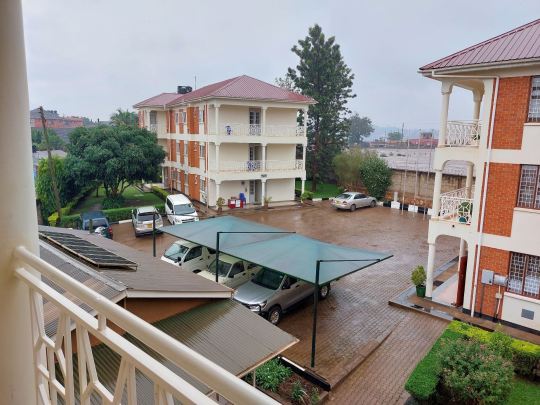
The two accommodation blocks.
Ewan and I had visited the conference centre and met the nuns in February. We thought our young delegates would like this setting, with lovely bedrooms and excellent conference facilities. As they arrived in the evening they were very impressed by the specially warm welcome and careful attention to detail by the nuns.
I was bowled over as we two came into the meeting room first thing this morning. The tables had been set out with beautiful soft blue pleated table cloths, and there were little pots of colourful artificial flowers on each. It all looked so pretty.

When I thanked Sister Lydia (with yet another hug), she waved lightly at her head and said “It all helps with mental health!”
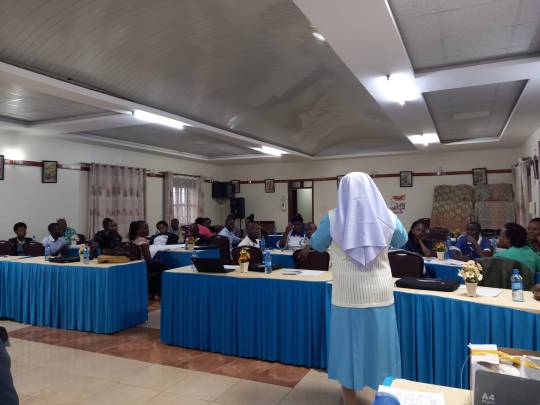
Sister Lydia opened our proceedings with prayer, including a beautiful soft musical prayer.
Our programme today began with getting our students together to catch up and share news of the challenges they have faced and solutions they’ve come up with. They love being together and there is a lot of laughter and affection for each other. Many of them work in relative isolation in rural areas or in the midst of big cities.
As with our patients, our mental health tribe of professionals face stigma from so many sources, and it’s great for them to join again with their colleagues and share their love for working in mental health.
The morning programme continued with reflections on a research paper which illustrated how many patients default from treatment, and the reasons for that. Often it’s because they want the treatment that will heal them completely. Like many conditions, major mental illnesses need long term treatment.

Two of the delegates with the JF bags they have just been given
This afternoon we were on drugs and alcohol!
We’ve had some changes in the programme, for example with the other two psychiatrists who were originally coming having to drop out. I’ve had a bit of extra work to do, both presenting material devised by others and also drastically pruning powerpoints so that my local colleagues could share in the presenting bit - they haven’t had the many years of practice I’ve had in ‘winging it’.
The programme includes subjects requested by the local teams and other items suggested by us from our observations. It’s a fun mix. We have a mix of presenters too.
5 notes
·
View notes
Text
1918 Labour Party General Election Manifesto
Labour's call to the people
The Labour Party has left the Coalition, and is appealing to the men and women of the country with a programme that is a challenge to reaction.
A peace of reconciliation
Victory has been achieved, and Labour claims no mean share in its achievement. Not only have the workers supplied the vast majority of our soldiers and sailors, and sustained the burden of war at home; the democratic diplomacy which found expression in the War Aims of Labour has been one of the most powerful factors in winning the war, and must be the most powerful factor in the rebuilding of the world. The Peace which Labour demands is a Peace of International Co-operation. It declares absolutely against secret diplomacy and any form of economic war, and demands, as an essential part of the Peace Treaty, an International Labour Charter incorporated in the very structure of the League of Free Peoples.
Hands off democracy!
Labour welcomes the extension of liberty and democracy in Europe. It has warned the Coalition that opposition towards the young democracies of the Continent, and especially that intervention on the side of European reaction, will be disastrous. Labour demands the immediate withdrawal of the Allied forces from Russia. In the interest of world-democracy it stands for the immediate restoration of the Workers International.
Freedom for Ireland
The principles which Labour acclaims as Allied war aims it will apply to our own subject peoples. Freedom for Ireland and India it claims as democratic rights, and it will extend to all subject peoples the right of self-determination within the British Commonwealth of Free Nations. Labour's appeal to the people is not a sectional appeal, unless an appeal which excludes only militarists, profiteers, and place-hunters be regarded as sectional. It includes all who are determined that the fruits of victory shall not be wasted in the interests of riches or reaction. Especially does Labour appeal to two sections of the community - to the soldiers and sailors who have fought the nation's battles abroad, and to the men and women workers at home.
No conscription
The returning soldier or sailor will find himself once more a worker. His cause is one with that of the workers at home. Civil and industrial liberties have been largely suspended during the war; and soldier and worker want their liberties back now. The Labour Party stands for the destruction of all war-time measures in restraint of civil or industrial liberty, the repeal of the Defence of the Realm Act, the complete abolition of Conscription, and the release of all political prisoners. It stands for free citizenship, a Free Parliament, for Free Speech, and against the domination of the Press by sinister political influences.
The land for the workers
The Labour Party means to introduce large schemes of land reorganisation, and it is fully aware that this can only be done in the teeth of the most powerful vested interests. land nationalisation is a vital necessity; the land is the people's and must be developed so as to afford a high standard of life to a growing rural population not be subsidies or tariffs, but by scientific methods, and the freeing of the soil from landlordism and reaction.
A million good houses
Labour demands a substantial and permanent improvement in the housing of the whole people. At least a million new houses must be built at once at the State's expense, and let at fair rents, and these houses must be fit for men and women to live in. Labour will press for a really comprehensive Public Health Act co-ordinating all health authorities, based on prevention rather than cure, and free from servile or inquisitorial features. It will also press for real public education, free and open to all, with maintenance scholarships without distinction of class, and for justice to the teachers, upon whom education finally depends.
A levy on capital
Labour will resist every attempt to place burdens upon the poor by indirect taxation. Labour is firm against tariffs and for Free Trade. The way to deal with unfair competition of imports made under sweated conditions is not by tariffs, but by international labour legislation, which will make sweating impossible. In paying the War Debt, Labour will place the burden on the broadest backs by a special tax capital. Those who have made fortunes out of the war must pay for the war; and Labour will insist upon heavily graduated direct taxation with a raising of the exemption limit. That is what Labour means by the Conscription of Wealth.
Industrial democracy
In industry, Labour demands the immediate nationalisation and democratic control of vital public services, such as mines, railways, shipping, armaments, and electric power; the fullest recognition and utmost extension of trade unionism, both in private employment and in the public services. It works for an altogether higher status for labour, which will mean also better pay and conditions. The national minimum is a first step, and with this must go the abolition of the menace of unemployment, the recognition of the universal right to work or maintenance, the legal limitation of hours of labour, and the drastic amendment of the Acts dealing with factory conditions, safety, and workmen's compensation.
The real Women's Party
Labour has always stood for equal rights for both sexes, when other parties were ignoring or persecuting women. In politics, the Labour Party stands for complete adult suffrage, in industry for equal pay and the organisation of men and women workers in one trade union movement. To the woman worker and to the wife of the working man or the soldier, Labour can make a confident appeal. Better pay and pensions for the workman or soldier mean better conditions for his wife and family. There must be no sex party: the Labour Party is the Women's Party. Woman is the Chancellor of the Exchequer of the home. Labour stands with the Co-operative Movement in its insistence on reasonable food prices and fair distribution, and in its resistance to unfair taxation. The Labour Party will do all it can to aid co-operators in their struggle for a democratic food organisation and against unfair discrimination. Labour and Co-operation are a single movement, and in the coming battle with reaction they must fight side by side.
Labour's programme is comprehensive and constructive. It is designed to build a new world, and to build it by constitutional means. It is a programme of national and international justice, founded on permanent democratic principles. Even in an election as sinister as this, in which a large part of the nation's youth is arbitrarily disfranchised by the Government, Labour confidently appeals to the country to support its programme of social justice and economic freedom.
#just stumbled across this while doing research for my fic#found it an oddly enjoyable read#long post#workers' rights#uk history
4 notes
·
View notes
Text
I am 59 years old. I am a white, cis, queer autistic woman married to a white, trans, genderfluid, queer, autistic person. I have some chronic health and mobility issues, and as I age, pain becomes more common in my life. For all of my adult life I had to mask hard to survive in an office working environment. All this is to say that I have pretty much always had limited energy to work with.
The bottom line is there is too much out there that needs doing for any individual to try and focus on everything. I care deeply about a whole lot of the things going on in the world, but I have to, for my own survival, narrow my focus when it comes to what I, personally, engage with. That includes what news stories I pursue and how much of current events I expose myself to on a given day.
The things I have cared most about in my life have shifted some over the years, but not significantly. I have always cared about the environment dating from the second grade (1972) and our teacher who was very focused on recycling and reducing consumption. I care about poverty and food insecurity because I lived it as a child. I care about elderly folks because of my family, and now myself and my spouse. I didn't actually come out to myself about being queer until I was in my mid 40s. I basically erased my queer identity until that point. Now I care deeply about queer and trans issues.
Does this mean I don't care about other stuff? Drug addiction, wars, police brutality? Of course not. But for my own sake, I have to focus on the things I care most about. It's OK to have a hierarchy and to have some issues that we put more energy into than others.
So how does this all play out in my actual life? I have automated monthly donations set up to go to five different organizations that treat on issues that matter to me, and those are just part of our monthly budget. Places like Doctors without Borders and Nature Conservancy.
For my career, I chose public service. I chose to work for my state's environmental agency. I eschewed higher paying programmer jobs in favor of working for a job where I was making a difference. I was able to spend 23 years in this job, caring about what I was doing, and knowing that my work was making life easier for environmental scientists and policy makers.
Now that I am fully retired, I have time and energy to devote to volunteer work. I am vice chair on the board of a non-profit municipal organization that is constructing fiber internet across the rural parts of our state to provide reliable high speed internet to the unserved and underserved in our state who have been utterly ignored by the for-profit providers for the last twenty five years. This work is important because it addresses basic economic struggles and disparities in our very rural state, and making opportunities available that haven't been available in this region for decades.
I am further volunteering at a local queer community center. I perform administrative tasks for them, and host a couple of different clubs several times a month, as well as just showing up for other events.
These things suit my nature and abilities. There are plenty of other things I could be doing. I could volunteer at the food bank, for the organizations helping unhoused people in my area, for various sexual assault recovery organizations, or for the group helping train women and gender expansive individuals how to do trades work (we have a desperate need for trades people in our state), or for the many organizations working to help restore us post-severe floods.
But none of these play to my skill sets or my interests in the same ways. I don't have energy to do all of it. So I choose the few things that I know I have energy for, and where I will be able to do a good and consistent job.
We have far too many young folks volunteering for our community center who burn themselves out volunteering for EVERYTHING and protesting EVERYWHERE all the time, all at once. They're trying to fix all of the problems by themselves and they're making themselves sick. Also, they are unreliable. We can't count on them when we need them because at any moment they are going to be flat on their backs again, and unable to function. You're not any use to anyone in that state.
Our energy and skills are finite. The best thing you can do is choose one, maybe two, smaller local issues/groups that mean the most to you, and focus on working with/for those issues. This doesn't mean you don't care about all the issues, it means you recognize your limitations as an individual, and that you're wanting to be effective in the work you do.
Being able to show up consistently when you say you will is something that organizations desperately need. We are chock full of people who are deeply passionate but also spread so thin we can't actually depend on them to show up when we need them. While it isn't useless to the organization, they do actually help when they're there, it just isn't help we can count on to show up when the chips are down.
Also, it's OK if your passions change over time. I didn't used to care more than tangentially in a vague way about queer stuff. Then my spouse came out as genderfluid, and I fully realized that I really was queer, and suddenly I was more interested in building queer community in my area. I have more friends now than I have ever had in my entire adult life.
Also, this is how you meet people (both in meatspace and online) that you can connect with. Get involved with a cause/interest/group that is doing something you care about. You'll find people like yourself who also care. It's a built in conversation and reason to meet up. This is how community is built, shared concerns/experiences.
anybody got tips and tricks on how to not go absolutely fucking insane because of the deranged world order we live in
11K notes
·
View notes
Text
Trapped in the Haze
Every winter, a thick, smoky haze blankets northern India, with cities like Delhi experiencing hazardous pollution levels. This is largely due to the age-old practice of stubble burning in Punjab and Haryana. Burning crop residue, or stubble, remains the quickest and cheapest way for farmers to clear fields after the paddy harvest, even though this method of clearing fields harms health, air quality, and the environment. Despite government policies and programmes aimed at curbing stubble burning, the high cost of machinery, lack of direct incentives, and limited time to prepare fields for the next crop leave farmers feeling trapped. This complex problem continues to create a recurring cycle of pollution affecting millions.
Practice of Stubble Burning
Stubble burning, the practice of setting fire to leftover plant stalks after harvesting, has long been a common method for farmers in Punjab and Haryana. For them, burning the stubble is a fast and cheap way to clear the fields before planting wheat, the next crop in their cycle. This practice requires no special equipment, making it accessible for small-scale farmers who often face economic pressures. Yet, this approach has severe consequences for air quality, health, and the environment.

Reasons Behind Stubble Burning
Economic Constraints and Lack of Affordable Alternatives: Small farmers face financial pressures that make sustainable options for crop residue management difficult. Expensive machines like balers and super-seeders are essential to managing crop residue without burning, but their cost is prohibitive for most small-scale farmers. Government subsidies aimed at promoting these machines have not been effective or accessible enough to address the scale of the problem. As a result, many farmers revert to the cheaper and faster method of burning.
Shrinking Cultivation Window: With the enactment of the Punjab Preservation of Subsoil Water Act in 2009, the government aimed to conserve water by delaying paddy planting until mid-June. However, this law also reduced the timeframe between paddy harvest and wheat sowing, making it even harder for farmers to adopt alternative residue management methods. This shrinking window pressures farmers to burn stubble quickly so they can move on to wheat planting.
Lack of Direct Incentives and Financial Support: Despite the potential of direct financial incentives to discourage stubble burning, the Central government has not yet implemented a robust programme to support this. The Punjab government proposed a system where the Central and State governments would share the cost, providing ₹2,500 per acre as an incentive for farmers to manage stubble sustainably. However, this proposal has not been approved. Without significant direct support, farmers are less motivated to switch from burning to sustainable practices.
Environmental and Health Impacts
The environmental and health impacts of stubble burning are far-reaching. The smoke produced by burning fields travels across states, causing air quality to deteriorate drastically in densely populated areas like Delhi. In 2023, Delhi’s air quality index (AQI) reached hazardous levels, with PM2.5 concentrations—fine particles harmful to human health—exceeding WHO safety guidelines by more than ten times. Such high levels of pollution can cause serious respiratory issues, aggravate chronic lung diseases, and even increase the risk of lung cancer. These health concerns extend to rural areas, affecting not only city dwellers but also farmers and villagers exposed to the harmful pollutants on a daily basis.
Government Efforts and Policy Gaps
Subsidies for Crop Residue Management (CRM) Machines: The Central government introduced a subsidy scheme in 2018 to encourage farmers to use CRM machines. Although this initiative aimed to help farmers manage crop residue without burning, these subsidies have not effectively addressed the problem. Many farmers find it challenging to operate and maintain these machines, and reports indicate that many of the subsidised machines have become redundant due to high operational costs.
Legal Actions and Penalties: In recent years, the government and courts have imposed penalties on farmers who burn stubble. Some farmers even face red entries in their records, which can affect their ability to get loans or sell land. However, these punitive measures often feel unjust to farmers, who are already facing economic hardship. Punishing them for a practice they feel they cannot avoid only adds to their burden, and coercive measures alone have proven insufficient in stopping the practice.
Success of Incentive Programmes in Haryana: Haryana’s initiative to offer a ₹1,000 per acre incentive for farmers who sell stubble to contractors has seen some success. Farmers who participate in this programme help supply stubble for biofuel production, reducing the amount of residue burned. This programme illustrates that with proper incentives, farmers are willing to adopt alternatives to burning. However, the programme is currently limited in scale and would need substantial expansion to address the problem on a larger scale.
Long-Term Solutions: Diversification and Sustainable Agriculture
Experts in agricultural policy suggest that one of the most promising solutions is to diversify the types of crops grown. In particular, farmers could shift away from water-intensive crops like paddy to alternatives that produce less residue, such as cotton and sugarcane. However, these alternative crops do not receive the same minimum support price (MSP) as paddy, making them less attractive to farmers. For crop diversification to be successful, the government would need to offer strong support for these alternative crops, including reliable pricing and better market access.
The Historical Context of Stubble Burning
The roots of the stubble burning issue can be traced back to the Green Revolution, which transformed Punjab into a rice-growing region to ensure food security. Traditionally, Punjab did not grow paddy, as its climate and soil were not naturally suited for it. However, with government support and high-yielding crop varieties, paddy production soared. Mechanised farming methods, such as combine harvesters, left long stubble in the fields, which could not be easily ploughed back into the soil. Consequently, burning became the easiest option. The legacy of these policy changes continues to impact farmers, who are now reliant on a crop that poses serious challenges for residue management.
Ethical Concerns and the Farmer’s Perspective
Many farmers feel the current approach to stubble burning is unfair. With limited resources and alternatives, they find themselves penalised for a practice that feels like a necessity rather than a choice. It is important to think about whether it is fair to punish poor farmers, especially since forcing them to change will not work on its own. Farmer unions and local organisations argue for a balanced approach that includes incentives and practical support rather than solely relying on penalties.
Technological Innovations and Potential Solutions
Exploring innovative and affordable technologies for stubble management could help. Newer technologies, like small-scale machines suited to smaller farms or community machinery sharing programmes, could make sustainable residue management accessible to more farmers. Moreover, integrating stubble into biofuel production or other industries, as Haryana’s incentive programme illustrates, offers promising possibilities. With such measures, India could take a step forward in addressing this recurring problem.
Conclusion
Stubble burning is a complex, multifaceted issue tied to historical agricultural policies, economic pressures, and environmental impacts. Although the government has implemented several measures to curb the practice, the support provided often falls short of the real needs of farmers. Expanding incentive programmes, investing in sustainable agricultural practices, and making affordable technology accessible to small-scale farmers are critical steps to reducing stubble burning. With these efforts, the thick haze that envelops northern India each winter could eventually start to clear, benefiting both the farmers and the millions affected by air pollution across the region.
1 note
·
View note
Text
Best Charitable Trust in Kolkata: Bridging Lives with Compassion and Service
Introduction to Genesis Educational and Charitable Trust (GECT)
Genesis Educational and Charitable Trust (GECT) was established on 21st April 2009 with a great hope to bring relief to the distressed in and around Kolkata. Among the best Charitable Trust in Kolkata, GECT is dedicated to the betterment of the downtrodden people of society through educational initiatives, healthcare services, and social welfare programs.

Supporting Tiger Victim Families
The vision of GECT goes beyond normal charitable activities; it also stretches out to the marginalized groups like tiger victim families in Sundarban. It is considered to be a Charitable Trust for Tiger Victim Families as GECT continues to rehabilitate, providing the much-needed monetary assistance, and educational aid to all victimized by the attacks of tigers in the harsh realities of Sundarbans. These endeavours not only ensure their survival but also show an offer of leading a dignified life after the loss of loved ones or means of livelihood.
Focus on Sundarbans
Situated in the Sundarbans, a UNESCO World Heritage site, and having such rich biodiversity with people living vulnerable conditions, GECT is a Charitable Trust for Sundarban that concerns itself with basic health care, education, and resources to some of the most remote parts of the world, unable to be reached by mainstream support in time of need. Affecting rebuilding lives flooded, cyclones, and the very unpredictable dangers presented from the wildlife of the region.
Empowering the Underprivileged
Besides these activities in the Sundarbans, GECT extends its initiative to the rural and urban deprived people staying across the city of Kolkata. GECT is a Charitable Trust for Underprivileged that undertakes free educational programmes, vocational trainings and health camps that empower people to be poverty-free. The trust believes that education is the way to a better life and thus invests significantly in providing access to quality education for children and young adults from low-income families.
Conclusion
Genesis Educational and Charitable Trust is considered one of the best Charitable Trust in Kolkata. With its rigorous commitment, it carries out welfare work in social matters that are multi-dimensional in education, health care, disaster relief, and supporting victim families from tiger attacks, all ending with the modification of lives and hope for a better tomorrow.
For more details:-
Genesis Education and Charitable Trust
Best Charitable Trust in Kolkata
1655, Rajdanga Main Road
Kolkata - 700107 (Near Kasba New Market)
Phone no:- +91 9062200739 +91 80170 14875
Gmail:- [email protected]
#charitable trust in kolkata#charitable trust for tiger victim families#charitable trust for under underprivileged#best charitable trust in kolkata#charitable trust for sundarban
0 notes
Text
UNDP Programs Target Elections, Humanitarian Crises, Sustainability

The United Nations Development Programme (UNDP) works globally to identify ways of meeting sustainable development challenges head-on. With a major focus on poverty, UNDP agencies seek to improve people’s lives across 170 countries, while protecting the planet. In many cases, its efforts are devoted to meeting the urgent needs of people living in conflict zones.
An example of the latter function came in June 2024, when the UNDP issued a Call to Action for resolving the unfolding humanitarian crisis in Gaza. The multinational organization committed to finding a way toward a ceasefire, a security framework that everyone could agree on, and the provision of needed goods, equipment, and material for rebuilding. The assistance plan focuses on creating a people-centered, Palestinian-owned approach to lasting engagement with local communities, so as to have the maximum socioeconomic impact.
Early recovery priorities include debris removal, including unexploded ordinance. The organization is formulating emergency job creation efforts that focus on restoring a stable private sector at all levels, including micro and small business. The UNDP will additionally direct infrastructure repair and critical services programs focused on water, sanitation, communications, and electricity, and provide transitional shelter to Gaza residents without housing. Focused on inclusion and protecting people’s rights, the program encompasses mental health and psychosocial support efforts as well.
The UNDP’s sustainability mandate involves implementation of the Paris Agreement on climate change. This was emphasized in the July 2024 Global Environment Facility (GEF) Council, which approved a $166 million UNDP Work Plan in support of 23 projects across 20 least developed countries. These projects tackle issues such as biodiversity loss, pollution, and climate change. A related mandate is to deliver affordable renewable energy that reaches an additional 500 million global citizens by 2025.
An example of such a project is a UNDP grant facility opened for applications in July 2024. The focus is on reducing land degradation processes in Kazakstan’s vulnerable semi-desert, steppe, and desert ecosystems. The agency encourages applicants capable of designing collaborative projects that bring together various nongovernmental organizations (NGOs) and serve to empower youth, women, and other vulnerable groups within local communities. UNDP also oversees outreach efforts such as a "Climate Does Not Wait” contest that engages schoolchildren in coming up with creative solutions to global warming.
Many UNDP programs involve partnerships with local institutions and businesses within the regions covered. The Mselen Partnership has an emphasis on economic empowerment and gender equality, and involves a collaboration with Solomon Islands Telekom Services.
Key elements of this ongoing initiative include working with women market vendors to boost financial literacy and business skills, in the process creating access to micro-insurance, credit, and livelihood protection. The focus is on rural areas across several islands and the process of ensuring that vendors are equipped with the means for digital financial management, including essential tools for making payments and receiving loans.
Another vital aspect of the UNDP mission centers on ensuring transparent, well run democratic elections that help advance human development potential. Through a comprehensive electoral cycle approach, UNDP representatives engage with political parties, media, and governing agencies in supporting the basic tenets of a stable, resilient civil society. This is particularly important for countries in the process of transitioning past authoritarian rule, into multifaceted democratic systems.
In May, 2024, the UNDP Democracy and Elections Project partnered with Mozambique’s National Union of Journalists and Technical Secretariat for Electoral Administration (STAE) in hosting a Media and Elections training series. This program brought together 42 journalists working to better understand the local and national election processes, and ways of ensuring unbiased, accurate electoral reporting. Participants went through interactive exercises that simulated pivotal situation at critical junctures in the electoral process, including the counting and tabulation of ballots.
1 note
·
View note
Text










THE WALES DIARIES ♚
2 NOVEMBER 2023 || SCOTLAND VISIT (2/3) - BRODIESHILL FARM, MORAY
The Duke and Duchess of Rothesay visited Brodieshill Farm as their second engagement of the day in Scotland to learn about efforts being made to better support the mental health and wellbeing of young people.
Developed as a way to provide a space for young children to explore and learn, Brodieshill offers an indoor and outdoor area for child-led play where families, including those based at nearby RAF Kinloss and RAF Lossiemouth, can focus and reconnect with their children and get together regularly as a group.
During their visit William and Catherine met members of the Lower Speyside Young Farmers and representatives from Farmstrong Scotland. Both of these organizations work towards promoting positive mental wellbeing in rural communities across Scotland and support local farmers.
Lower Speyside Young Farmers is run for young people from any background from the ages of 14 - 29 across the local area. It provides opportunities for socialising and interaction in what can sometimes be an isolating environment.
Farmstrong Scotland is committed to the wellbeing of farmers and rural communities and it runs programmes to improve individual mental and physical wellbeing and, in the process, supports local businesses to thrive. William and Catherine also met and spent time with the families who attend regular sessions at the farm's dedicated play area.
#the wales diaries#the wales diaries 23#engagement diaries 23#engagement diaries#the engagement diaries#british royal family#british royals#royalty#royals#brf#royal#kate middleton#catherine middleton#duchess of cambridge#british royalty#prince of wales#the prince of wales#the princess of wales#princess catherine#catherine wales#william wales#princess kate#prince william#ScotlandNov23.2#ScotlandNov23#my edit#royaltyedit#royalty edit
43 notes
·
View notes
Text
Fostering Resilient Communities: Initiatives for Building Disaster Preparedness in Vulnerable Communities
Disasters, whether natural or man-made, have adverse effects on vulnerable communities and their livelihoods. Due to their lack of access to resources as well as social and economic barriers, vulnerable people and communities can take much longer to bounce back from the effects of any emergencies or disasters. It is therefore of utmost importance that vulnerable communities are provided with the support they need during emergencies for ensuring access to critical aid and also for building resilience for any future emergencies. Ensuring disaster preparedness for vulnerable communities is crucial to mitigate the impact of these events and build resilience. This post explores initiatives that focus on enhancing disaster preparedness for vulnerable groups, highlighting the importance of community engagement, education, and resource allocation.
Vulnerable communities include populations more likely to suffer from the impacts of disasters due to socio-economic, geographic, or health-related factors. These groups often include the elderly, children, people with disabilities, low-income families, and those living in disaster-prone areas such as coastal regions, floodplains, and earthquake zones. Disaster preparedness for vulnerable groups involves tailored strategies that address their specific needs and circumstances.

Community Action Collab is a dynamic humanitarian emergency platform that builds the resilience of Vulnerable People and their institutions, in their everyday emergencies, and is ready for future humanitarian crises. The platform orchestrates and facilitates providing aid to vulnerable communities through partnerships. The comprehensive approach of emergency initiatives is particularly effective in enhancing disaster preparedness for vulnerable communities as it leverages local knowledge and capacities.
Key Elements
Some key elements of fostering disaster preparedness includes the following factors,
1. Risk Assessment and Mapping : Engaging community members in identifying hazards and mapping out areas of risk. This participatory approach ensures that the specific vulnerabilities of different groups are considered.
2. Capacity Building : Providing training and resources to community members to improve their preparedness and response capabilities. This includes first aid training, evacuation drills, and the establishment of local emergency response teams.
3. Community Early Warning Systems : Developing and implementing early warning systems that are accessible and understandable to all community members, including those with disabilities. In coastal regions, community radio and mobile alerts can be used to warn about impending cyclones and tsunamis.
Education and Awareness Campaigns
Education is a powerful tool in fostering disaster preparedness for vulnerable groups. Tailored awareness campaigns can significantly enhance the preparedness of communities by informing them about the risks and the actions they can take to mitigate these risks.
1. School Programmes : Integrating disaster preparedness into school curriculums ensures that children understand the risks and know how to respond in case of an emergency. Schools can also conduct regular drills and engage parents in preparedness activities.
2. Public Awareness Campaigns : Using various media channels to disseminate information about disaster risks and preparedness measures. These campaigns should be inclusive, considering the literacy levels and language preferences of different community groups. In rural areas, street plays and local language broadcasts are effective in spreading awareness.
3. Community Workshops : Conducting workshops and training sessions at the community level to educate residents about disaster preparedness. These workshops should be interactive and practical, providing hands-on training in emergency response skills. NGOs have been actively involved in conducting such workshops across different states.
Inclusive Disaster Planning
Effective disaster preparedness for vulnerable communities requires inclusive planning processes that actively involve representatives from all community groups. This ensures that the unique needs and perspectives of vulnerable populations are integrated into disaster management plans.
1. Stakeholder Engagement: Involving local leaders, NGOs, and community organisations in the planning process. These stakeholders can provide valuable insights and help mobilise resources for disaster preparedness initiatives. For instance, involving women's self-help groups in disaster planning has proven effective in many regions.
2. Accessible Communication: Ensuring that all communication regarding disaster preparedness and response is accessible to everyone, including people with disabilities. This may involve using multiple formats such as braille, sign language, and audio messages. In urban areas, mobile apps with voice-over features can be beneficial.
3. Resource Allocation : Prioritising the allocation of resources to the most vulnerable groups. This includes ensuring that shelters are accessible to people with disabilities, providing financial assistance to low-income families, and ensuring that medical supplies are available for those with chronic health conditions.
Disaster preparedness for vulnerable communities is a vital component of effective disaster management. By implementing community-based approaches, enhancing education and awareness, involving all stakeholders in planning, and leveraging technological innovations, we can build resilient communities that are better equipped to withstand and recover from disasters. As India continues to face the challenges of a changing climate and increasing urbanisation, it is essential to prioritise the needs of vulnerable groups and ensure that disaster preparedness efforts are inclusive and comprehensive.
0 notes
Text
Marpu Foundation’s Role in Shaping Corporate Social Responsibility (CSR)

In today’s world, businesses are expected to go beyond profit-making, and that's where Corporate Social Responsibility (CSR) comes in. One organization leading the charge is the Marpu Foundation, known for its transformative efforts that connect corporations with communities in need. Through initiatives like water conservation, sustainable development, and nutrition, Marpu Foundation is helping businesses make a real impact, all while aligning with India’s Sustainable Development Goals (SDGs).
Water Conservation: CSR in Action
Water scarcity is a huge issue, and Marpu Foundation is tackling it head-on. By partnering with businesses, they’ve launched projects like borewell construction and water plant installations in rural areas. This doesn’t just align with SDG 6: Clean Water and Sanitation, but also provides companies a way to contribute to long-term solutions in communities facing water shortages. If you’re looking to make your CSR initiatives truly meaningful, working with Marpu is a game-changer.
Poshan Abhiyaan: Fighting Malnutrition
Malnutrition is another pressing issue in India, and through partnerships with Poshan Abhiyaan, Marpu is making a difference. They support underprivileged communities by providing food and healthcare, directly contributing to SDG 2: Zero Hunger and SDG 3: Good Health and Well-being. For businesses, this means an opportunity to extend their CSR reach and improve the lives of people in vulnerable communities.
Green Jobs: Sustainability Meets Economic Growth
Marpu Foundation is also at the forefront of creating green jobs through their Green Skill Development Programme (GSDP). By training individuals in eco-friendly practices, they’re helping both the planet and local economies. It’s an innovative way to support SDG 8: Decent Work and Economic Growth and SDG 13: Climate Action. Businesses can get involved by promoting sustainability in a way that’s both socially and environmentally responsible.
Partnerships for Sustainable Impact
What makes Marpu Foundation stand out is their collaborative approach. By joining hands with initiatives like the Jal Jeevan Mission and the Atal Mission for Rejuvenation and Urban Transformation (AMRUT), Marpu helps businesses align their CSR efforts with SDG 11: Sustainable Cities and Communities. It’s all about sustainable urban development and improving the quality of life in these areas.
Final Thoughts
If your business is looking for a way to make a real difference through CSR, the Marpu Foundation offers a path forward. From water conservation to green jobs, their projects allow companies to contribute to sustainable development while fulfilling their corporate responsibilities. Partnering with Marpu ensures that your business is not just checking boxes but making an impact that will last.
0 notes
Text
Artist Research - Robert Sae-Heng
Graduated from the University for then Creative Arts with a BA in Illustration and now lectures on an illustration programme. He documents his travels and explorations with pencil and paper, he illustrates cultures that aren’t his own to ‘better understand his place in the world’.his work is used in advertising, magazines, and restaurant branding, he has also illustrated a book.
Sae-Heng was born deaf and used art to communicate and it also helped him to process the challenges Sae-Hung faced as a working-class child in rural Mexico. His artwork was being used to communicate before Sae-Heng could read, write, or speak, so it became a form of escapism.
Robert Sae-Heng uses colour, texture in the form of mixed-media. He uses hand drawn images and then finishes digitally. Some of his works have also been animated, like on his website.
Running helps Sae-Heng overcome a creative block because it is how he subconsciously processes his ideas and finds clarity; it also has benefits to his mental and physical health. Sae-Heng often questions wether his work will be able to sustain him 10 years into the future, but his solution is to have faith in his own abilities, he knows he has the skills and experience to continue his career.
If I were doing Robert Sae-Heng’s work I would enjoy it because I like the mix of traditional and digital work. I’d struggle holding workshops for others because I do not have that edge on others to be able to teach them skills I have not perfected myself. I think that I would incorporate different types of traditional media like print and not just pen and paper then finish on a digital platform.
In the scale of the world Sae-Heng is successful and I can see myself being a similar sort of position because creating art for magazines with a brief makes more sense to me, I sometimes struggle to create art for the sake of art and have to do something guided so I think it would be beneficial for me. Again, compared to Sae-heng I am an illustration baby but seeing his journey being similar to mine in terms of communication, makes my future more clear.


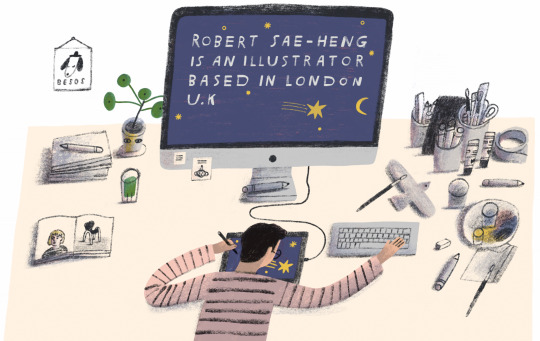

Sources:
0 notes
Text
Scholarship for MBBS Students: Making Education Accessible
The costs involved in studying medicine are quite high. Different types of scholarship for mbbs students meant for students pursuing an MBBS degree have been put in place in order to lessen the financial burden. This work will focus on looking into the role of scholarships in the life of an MBBS student, the different forms of scholarships available, and how to go about the application procedure successfully.
The Significance of Scholarships
Context of studying, particularly in such complex and demanding courses like medicine, the role of scholarships is indeed paramount in making education more accessible.
They not only help to ease the financial burden but also help to acknowledge the efforts and commitment as well as the capabilities of a student.
For a number of people, this seems more because it can mean the difference between studying for an MBBS and not getting that scholarship.
Given the ever-increasing fee, books, and upkeep costs, scholarships assist in alleviating the financial pressure thanks enabling students to give maximum concentration to their studies without any debt.
Categories of Scholarships for Medical Students (MBBS)
Merit-Based Scholarships: Candidates often have good grades or higher percentile rankings in the qualifying entrance examinations. Such merit scholarship for mbbs students is competitive and encourages the students to strive towards the merits in their studies.
Need-based Grants: This is given to students as per their social economic status. Need based scholarships help needy families to pay their tuition and other education related costs.
Scholarships from the Government: Lots of countries provide their respective national medical scholarships with regard to MBBS for the medical students.These kinds of scholarships are aimed to enhance the number of citizens opting for studies in medical and health allied courses. They could have some conditions such as being a national of those countries, or requiring them to work in the rural areas for a certain period of time after completion of the study.
Institutional Scholarships: Colleges of medicine and Universities have their own schemes for award of scholarships to students pursuing medical education. These may be purely academic, financial or a mix of the two. It is important that any other student wishing to apply for any scholarship for mbbs students does so with knowledge of the institution he or she is applying to.
Independent and Charitable Institutions: There are a number of private and even charitable institutions that award scholarships to MBBS students. These entities tend to have particular conditions to be met, for instance, serving minority groups within the profession or the need for interest in volunteer work.
Scholarships for Study Abroad: Most of the postgraduates report to be interested in pursuing study abroad opportunities for MBBS programs. Such international scholarships are often made available by various universities and organizations for MBBS programmes that are in most cases expensive.
Tips for Visiting Application Essay Scholarship Platforms
Scholarly scope: examine possibilities for scholarships when studying for an MBBS degree offered by different universities, countries, and organizations, which include donations, compromises, and other charitable institutions.
Know The Scholarship Criteria: Understanding the reasons that would help establish whether a student would be awarded a particular scholarship would be one of them. Be sure to understand all such considerations and your position on them before making any move with regard to scholarship applications.
Compile Everything That is Needed: With most of the scholarship application forms, there are certain documents that are usually needed such as the students transcrips, recommendation letters, personal statements and so on. Therefore, get all the relevant documents early enough in order to avoid last minute scrambling.
Create an Effective and Informative Personal Statement: A personal statement makes or breaks the application and should, therefore, be well written. Always express your interest in medicine, your ambitions related to the profession, and how the award will assist you in reaching them.
Adhere to Timeline Constraints: Necessarily vigilant with time frames of scholarship for mbbs students applications. Submitting your application way before the deadline dates can help in showing the dedication towards the purpose and also will help in case of any last minute hiccups on the part of the applicant.
Follow Up: Once your application has been sent, you may wish to contact the appropriate office to follow up on the status of your bequest. This may convey your interest and may help in keeping your application in sight.
Conclusion
A great significance is attached to the Scholarships for MBBS students in realising the dream and making it happen. The ubiquity of these awards reduces the medical school tuition burden and advances the practice of medicine in every aspect. With available alternatives for scholarships, students should utilize these opportunities by trying them out and doing the appropriate applications. Thus targeting these scholarships, students wishing to be doctors will be able to concentrate only on studying and preparing for the future worthwhile profession which is the healing profession. In the end, these individuals will be of great service to the healthcare industry and will help greatly in the communities where they will settle down.
0 notes
Text
“At home” in Kisiizi, and encouraging developments
2nd March 2023
“At home” in Kisiizi, and encouraging developments
2nd March 2023
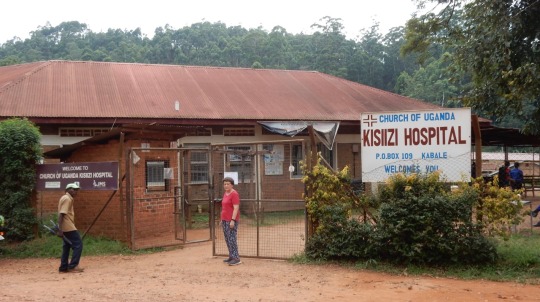
In one of our conversations at Kisiizi, Moses the hospital secretary reminded us that Kisiizi was our “second home”. Our welcome certainly suggested that we were part of the family. How lovely.
Georgious is the Psychiatric Clinical Officer who leads the mental health service at Kisiizi. His report was exciting as he told us of new developments and possibilities. And perhaps most importantly, we heard Georgious’s enthusiasm, leadership and vision.

The ward and patient shelter
mhGAP training, sponsored by JF, has proved to have had remarkable results.
When Covid struck, and senior mental health professionals couldn’t travel to the outlying clinics, the newly trained staff at the rural health centres carried on providing mental health treatment and support as they now know what to do.
A young clinician trained in mhGAP has been promoted to in-charge of the mental health ward.
Prima, who qualified in Child and Adolescent Psychiatry, was inspired to renew her adult mental health skills by mhGAP training.
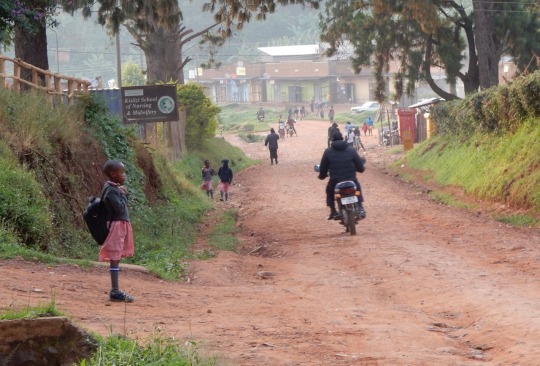
On her way to school
Georgious is much more confident that if he has to be absent, the young team collaborate to share the responsibility of caring for the patients together. Georgious is in no doubt that mhGAP has made a significant difference. He says that staff are eager to apply their new knowledge and skills, and he can see the development in the way they work. His newly trained colleagues say they are not just wanting to pass exams as they were during their studies, they really want to use what they have learnt. And a good proportion of the mhGAP trainees have continued to practise their new skills.
Georgious has also led the workshops for Community Leaders’ Sensitisation. He says there is now clearly much better understanding of the nature of mental illness and epilepsy. The mental health team have a very good partnership with local teachers, and the police continue to refer potential patients.
Perhaps most excitingly, some of the pastors have really begun to change both their thinking and their practice. One pastor, for example, has identified 12 people who might have epilepsy or mental illness, brought them to the hospital, and stayed with them as they were assessed and started on treatment. He is now following them up and ensuring that the patients continue with their treatment.
This is a wonderful development, as the local church pastors are key people in their communities. Both we and Georgious are very hopeful that many more might follow this example.
If you have contributed to Jamie’s Fund in the last few years, your donation has helped to bring about all of this remarkable progress. Thank you so much for that.

Mobile phones get everywhere!
Georgious would like to expand the workshop programme to district level – he says that the district teams meet many patients and have the potential to be very supportive. Conversations with Kuule, who works at Bwindi hospital, have encouraged Georgious to make plans also to sensitise Village Health Volunteers – more key players in the life of village communities.
We were pleased that Dr Henry, the relatively new Medical Superintendent, was listening closely to Georgious’ report. Together with Moses we needed to have some discussion on matters less encouraging and more challenging. The team lost a patient to suicide recently, and this has provoked a renewed discussion on security, and their protocols on risk assessment and observation.
Another challenging issue is the number of patients who stay too long! Several patients have been left on the ward and abandoned by their families. In some cases they can’t even tell the team where they come from. In spite of best endeavours using community networks to try to trace the families, these have failed. The ward is left with these people who are technically no longer patients and have long been ready for discharge. Others are held until the families come to pay the fees due.
Kisiizi’s aim has always been “care for the vulnerable” and the management see this group of people as in that category. But the situation means that the mental health service has a big bill assigned to it, even when these individuals should not be there and aren’t a cost in terms of mentally illness. It is more a social work issue. This is a huge challenge. There is also an imbalance of unwell and well people, and too many extra beds down the middle of the wards.
We also talked of the Good Samaritan Fund, which provides for patients and families who cannot afford to pay for their psychiatric medicines. Georgious is of the view that if they could further expand community services and keep people well, patients would be less likely to relapse and need comparatively expensive medication. I think he is right.
When we were here last year we were struck by the negative impact of covid. It seemed to us that the whole country was depressed. This time it’s not so obvious, but there are still some concerns.
There is increased poverty, and fewer patients attending the hospital, resulting in a lower income. Patients not attending means they don’t get care from the team, and they probably don’t get medicine either, resulting in a higher number of patients relapsing.
There are psychosocial effects: increased rates of gender based violence, for example. Children have not been in school, and Georgious feels that many of them are losing hope. Some teachers took to alcohol during lockdowns. Higher pregnancy rates in girls and young women have negative results in many ways.
Families are less likely to afford medication because they have so little income; in addition, the drugs have became much more expensive, something we’ve seen around the world.
Kisiizi Hospital has, as always, tried to help the most vulnerable, and the School of Nursing has provided food for poorer patients where relatives cannot prepare meals for the inpatients.
The discussion took much of the morning. You remember that in a previous blog one of the sisters said they appreciated us coming because they felt loved. Moses commented that “when Ewan and Mo come it’s like an Annual General Meeting”!
But he also reminded us that “even if it’s a flying visit it’s important for us.” It’s important for JF too – we need to know that the funds you donate and we distribute are being put to the best use.
They are.

The vehicle bought by JF years ago with funds raised from a sponsored cycle. Still going well and 190,000 km on the clock.
5 notes
·
View notes